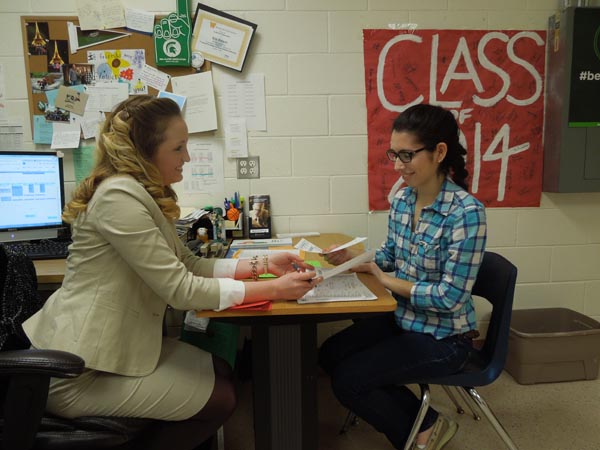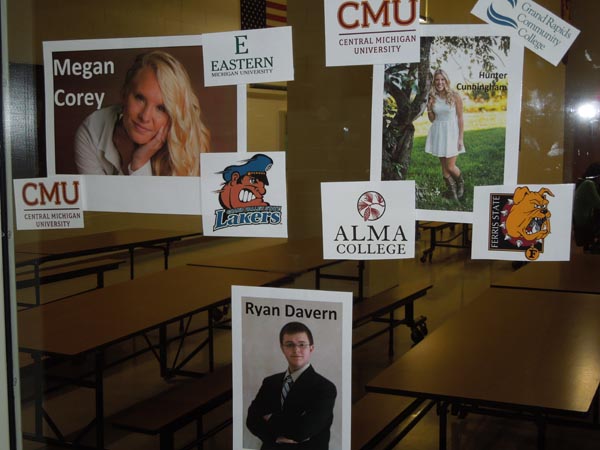Putting a college advisor in every Michigan high school
IONIA – A 33 and a 4.0.
Kylie Horrocks repeats the figures for emphasis, recounting the high school senior who had come to her for advice with a 33 on his ACT (in the top two percent of all the high school juniors in Michigan) and a 4.0 grade point average.
At a lot of high schools, the boy would be applying to go to the University of Michigan or Ivy League schools.
But this was Ionia High School, where almost six out of 10 graduates don’t go to college, and only three-in-10 enroll at a four-year university. Among economically disadvantaged students, just two-in-10 walk onto a four-year campus.
“He told me he was going to L.C.C. (Lansing Community College),” Horrocks recalled.
Horrocks is a member of the Michigan College Advising Corps, which places young college graduates in low-income schools and rural schools to encourage students in those schools to seek college educations. Horrocks begged the boy to apply to four-year universities. “There are so many things you can do,” Horrocks said she told the teen.
The boy relented and applied to Lawrence Tech in Southfield. To his surprise, he was admitted and received a large scholarship.
“Even when they have the opportunity, they often don’t take it,” Horrocks said. “It’s not in their mindset that these schools are even a possibility.”
Michigan’s low-income students are less likely to enroll in college, less likely to attend four-year universities, and less likely to attend selective schools when the do enroll, than their wealthier peers.
MORE COVERAGE: Lack of college guidance keeps poor and rural students from applying
Horrocks and a cadre of 40 recent graduates of Michigan State University and the University of Michigan are trying to change that. The fledgling college advising program may be doubling in size next year, parachuting 80 recent college grads into low-income and rural high schools across the state to offer free college advice to kids who often don’t have a clue how or where to enroll.
The Michigan College Advising Corps, which next year will be rebranded as AdviseMI, is an effort to give low-income and rural students access to the same college guidance and support that their wealthier, suburban peers get, often through private fee-based services.The cost of the advisors, which totals about $45,000 a year including salary, benefits and training, is paid by a combination of state and federal funds, as well as support from participating universities.
After-school academic services afforded to more affluent students contribute to the college access gap between low-income and higher-income students.
For those who because of finances or geography do not have access to fee-based guidance, school counselors are often the only place to turn for advice. But with Michigan’s school counseling ranks decimated by budget cuts (Michigan schools average 706 students per counselor, the fifth-highest ratio of students-per-counselor in the nation.), counselors seldom have adequate time to offer in-depth college advising, particularly at lower-income schools.
Run by the Michigan College Access Network, the Michigan College Advising Corps recruit college grads in the same vein as AmeriCorps and Teach for America.
Corps members sign up for a two-year stint in a high school. They get four weeks of training and earn $24,000 a year plus benefits. Most are not education majors. “We get students with a strong sense of service who are interested in a gap (period) before grad school,” said Chris Rutherford, program manager of the program at the University of Michigan. “Our advisors are not counselors or social workers. Their primary goal is to get students who weren’t considering college to consider it, and students who were considering community college to consider four-year universities.”
Different outcomes
College was dinner table talk for Erin Fischer when she was growing up in Belleville. It wasn’t for many of her friends in the blue collar town near Detroit.
“We didn’t have representatives from colleges come and talk to us” at the high school, Fischer recalled. “There was one guidance counselor for the entire school, so we didn’t have a lot of one-on-one meetings about what our plans were post-graduation. There weren’t a lot of announcements about scholarships or college open houses.
“My friends and I ended up in very different places post-graduation,” said Fischer, who graduated last spring from U-M with a bachelor’s degree in biopsychology, cognition and neuroscience. “It was never at all that they weren’t qualified or weren’t willing to work; they just weren’t having the same interaction outside the classroom that I was.”
Fischer is providing those interactions to a crop of kids at Lansing Eastern High School. At the urban, high-poverty school, the average ACT score is below 15 (the state average is 20.1) Only one-in-seven will enroll at a four-year college.
“The few students who are looking at four-year universities are very apprehensive,” Fischer said. “I’ve talked to students with a 26 ACT and a 3.9 GPA, who say, ‘Well, Miss Fischer, I’m going to apply to Western (Michigan University), but I’m probably not going to get in (an ACT score of 26 is higher than more than 75 percent of students accepted at Western).
“We have plenty of posters hanging up showing average incoming scores at all 15 public universities,” Fischer said. “They (her students) are not at the bottom of the pile. But they still feel they’re not good enough. It’s really hard to instill a sense of self-esteem in students who, depending on life’s circumstances, have had that taken away from them.”
Someone to inspire
The job of Advising Corps members is part cheerleader, part research assistant, part editor and part advocate. Fischer has been known to drive scholarship applications to universities to make deadlines and call admissions officers to make a case for getting students accepted off wait lists.
“I know a lot of people who weren’t planning to go to college at all and now are going to go to LCC,” said Lansing Eastern senior Cat Hinton. Fischer encouraged Hinton to apply to her dream school (Michigan State) and helped her navigate financial aid forms. “She (Fischer) explains how this can help you in your life,” Hinton said.
When she was accepted at MSU, Fischer greeted her with an green-and-white MSU donut.
“I’m going to tell my grandchildren about Miss Fischer – she made my dreams come true,” Hinton said. “Every school should have a Miss Fischer.”
Moving the needle on enrollment
The Michigan program is too new to have data demonstrating its effectiveness, but an identical national parent program, the College Advising Corps, has an impressive record. In schools around the country with College Advising Corps members, students who met at least once with advisors were 30 percent more likely to apply to college, 18 percent more likely to apply to three or more colleges, and 26 percent more likely to fill out federal financial aid forms.
A Stanford University study found that students who enrolled in college from schools with College Advising Corps staff members were as likely to still be in college two years later as the general population of university students – a major success, considering that the advisors work primarily with low-income students and students whose parents didn’t attend college.
That same study found that students from schools with College Advising Corps members were 8 percent to 12 percent more likely to enroll in college than students at demographically similar high schools without advisors.
A 10-percent growth in college enrollment among low-income and rural students would have the potential of providing a big boost to the Michigan economy (workers with a bachelor’s degree earn on average 70 percent more than high school graduates).
Changing the culture
The windows that border the cafeteria of Ionia High school are covered in senior photos. Beside each senior photo are logos of colleges where they’ve been accepted. Down a hallway is a poster that is updated weekly with the percentage of seniors who have turned in the FAFSA – the federal financial aid form.
Horrocks held two college financial aid nights at the school. After the first, she called every family who hadn’t attended, asking them to show up at the next session. She’s met with every senior at least three times. Later this spring, she’s organizing a countywide college fair, with representatives from more than 30 colleges scheduled to attend.
Evelyn Velasco is an Ionia junior who is already getting help from Horrocks. Her parents are immigrants from Mexico. Her mother works as a cleaner and her father works in a factory. That’s typical in a community where just 9 percent of adults hold a bachelor’s degree or higher – about one third the rate in the state (26 percent), and lower than Detroit (12 percent). There are no tutoring services in Ionia. The closest ACT prep service is an hour away.
With Horrocks’ help, Velasco is exploring the possibility of attending Aquinas College in Grand Rapids or Grand Valley State University. If she can get in, and if she can afford it.
A lot of students like Velasco are “admissible to whatever school they want to go to,” Horrocks said, “but when their parents didn’t go to college, they don’t know how to start the process.”
Overall college enrollment among Ionia grads hasn’t budged, but enrollment in four-year colleges has increased from 22 percent to 32 percent among all students, and 13 percent to 20 percent for low-income.
Those figures are still below the state averages. While the ACT scores at the school are close to the state average, college enrollment from the school, and at other Ionia County schools, is among the worst in Michigan.
It takes time to create a college-going culture, Horrocks said. That’s why she feels it’s vital for the program to be maintained in schools for years to come.
The complexities of funding for the program make it a challenge to maintain and expand. Advising Corp member salaries and training are paid for through state and federal funds, as well as support from participating universities.
Next school year, the number of universities recruiting and coordinating Corps members will grow from two to 10, with plans to double the number of advisors to 80.
It’s a big jump, aided by an additional $1 million in Gov. Rick Snyder’s proposed budget. But it’s still just “a Band-Aid solution,” said Brandy Johnson, executive director of MCAN, which coordinates the program.
Every high school in the state needs a college advisor, Johnson said. At $45,000 per year for training, salary and benefits, the advisors could be cost-effective investment in Michigan’s future.
Here’s the math: If an advisor that costs $45,000 a year in salary, benefits and training is able to persuade just two students who weren’t going to college to enroll in four-year universities and they earn bachelor’s degrees, those students will each earn, on average, $23,000 more per year than they would have as high school grads. That’s $46,000 pumped into the economy each year for a $45,000 investment, from just two additional students making it onto campus.
If the state picked up the tab for these college advisers in the 300 Michigan high schools with the lowest college enrollment rates (roughly half the state's high schools), it would cost the state $13.5 million a year.
“Putting a college adviser into schools is an investment in the community,” said Ionia corps member Horrocks. “There is some up-front cost, but even being here less than a year, I’ve seen how it’s changed some of the students.”
Support for this project was provided by The Equity Reporting Project: Restoring the Promise of Education, which was developed by Renaissance Journalism with funding from the Ford Foundation.
Michigan Education Watch
Michigan Education Watch is made possible by generous financial support from:
Subscribe to Michigan Education Watch
See what new members are saying about why they donated to Bridge Michigan:
- “In order for this information to be accurate and unbiased it must be underwritten by its readers, not by special interests.” - Larry S.
- “Not many other media sources report on the topics Bridge does.” - Susan B.
- “Your journalism is outstanding and rare these days.” - Mark S.
If you want to ensure the future of nonpartisan, nonprofit Michigan journalism, please become a member today. You, too, will be asked why you donated and maybe we'll feature your quote next time!


 Kylie Horrocks, left, meets with Ionia High School junior Evelyn Velasco to discuss Evelyn’s college plans. Only 9 percent of Ionia adults have a bachelor’s degree or higher, one third of the state average. Creating a college-going culture in Ionia, and other low-income and rural communities, is part of the goal of the Michigan College Advising Corps. (Photo by Ron French)
Kylie Horrocks, left, meets with Ionia High School junior Evelyn Velasco to discuss Evelyn’s college plans. Only 9 percent of Ionia adults have a bachelor’s degree or higher, one third of the state average. Creating a college-going culture in Ionia, and other low-income and rural communities, is part of the goal of the Michigan College Advising Corps. (Photo by Ron French) Erin Fischer, third from left, is a Michigan College Advising Corps member assigned full-time at Lansing Eastern High School to try to help students navigate the college application process. Some of the seniors who are heading off to college next fall with the help of the program are, from left, Kayleen Petrovia (headed to Ohio State or the University of South Carolina), India Graham (Pace University) and Cat Hinton (MSU). (Photo by Ron French)
Erin Fischer, third from left, is a Michigan College Advising Corps member assigned full-time at Lansing Eastern High School to try to help students navigate the college application process. Some of the seniors who are heading off to college next fall with the help of the program are, from left, Kayleen Petrovia (headed to Ohio State or the University of South Carolina), India Graham (Pace University) and Cat Hinton (MSU). (Photo by Ron French) Photos of seniors, along with the colleges at which they’ve been accepted, line a wall at Ionia High School. (Photo by Ron French)
Photos of seniors, along with the colleges at which they’ve been accepted, line a wall at Ionia High School. (Photo by Ron French)
